Let’s get going with your Inventory Items. You’ve got two options:
- Enter Items manually
- Import your Items
You may end up doing a combination of both. I’ll talk first about importing Items and then dive into how to create Items manually.
Importing Items
If you already have a spreadsheet (Excel, NeoOffice, etc.) of your current inventory items, you’re ahead of the game. We can help you import those items all at once.
You’ll need to have the following columns on your spreadsheet:
- Item Name (each one must be unique)
- Item Category
- Acquisition Date
- Acquisition Quantity
- Rental Price (not technically required but highly recommended)
You can have tons more info than that but those are all of the required fields to get you started. The more info you include on your spreadsheet, the less you’ll have to go back and enter manually later. To learn more about the other fields you could include on the spreadsheet, keep reading below about the fields involved in manually entering your items.
Once you have a spreadsheet that includes all of the required columns, send it on over to us at help@rwelephant.com. We’ll do all the back-end magic to import your Inventory Items and let you know when you’re good to go.
Please keep in mind that you’ll need to manually assign photos to the Items once they are imported. That can’t be done through the spreadsheet.
If you don’t already have your items on a spreadsheet, you certainly can start by filling out this sample spreadsheet we’ve provided. But I always say you should start where you’re at. If you don’t already have things in a spreadsheet, we actually recommend that you just jump right into entering items manually.
Adding Items Manually
Navigate to the Items icon in the upper left corner of your browser screen.
Start by creating an Item Category. Click on the “+” button in the upper corner of the left column.
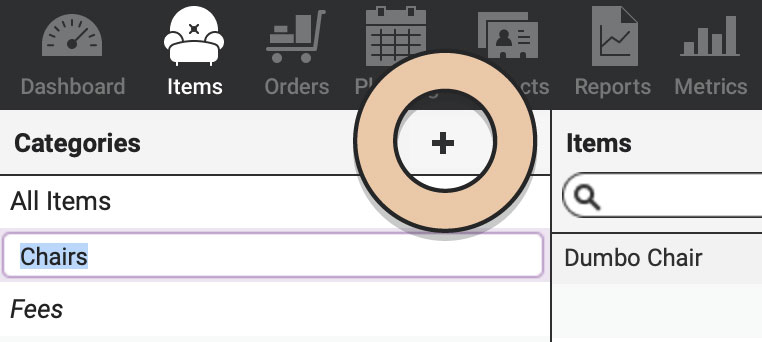
Double click on the text and type the name of the Item Category.
Feel free to create all of your Item Categories right now or do just one. Whatever you prefer is just fine.
With the Item Category selected, click on the “+” button at the top of the second column, the Items column.

Keep in mind that you can only add new items to specific Categories. If you have selected “All Items” in the left column, you won’t be able to add a new Item.
In the New Item pop-up, you’ll have a chance to enter all the required fields to get started with an Item. You can enter and store more Item Detail in RW down the road, but for now, you’ll only enter the necessities.
First, type the name of your Item. We suggest that you use unique names for all of your items.
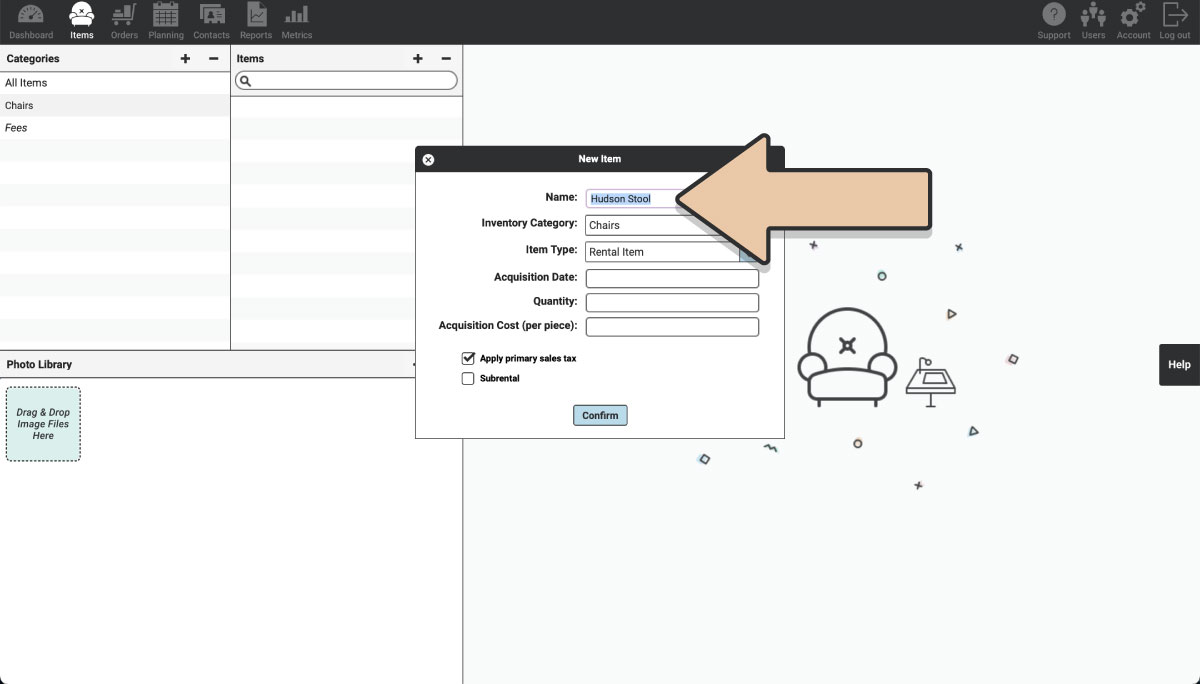
Naming items with women’s names (Jane, Sue, Mary, Tess) or European cities (Berlin, London, Rome, Avignon) could be a good place to start. You’ll find that it is a helpful way to keep your staff, your clients, and other vendors on the same page about your items. Because RW Elephant is a highly-searchable database, there’s no need to name your items serially or systematically like SK090UH Linen: Round: 90-inch: Pleated: Damask: Red. Instead, you can have “90-inch Red Samantha Linen,” “90-inch Green Samantha Linen,” “120-inch Round Green Joan Linen,” etc. If you already have a coding system, you can include that in the custom ID that we’ll talk about in a bit. But we suggest that you keep your item names as simple as possible by making them unique.
While we’re on the subject of naming Items, we should talk for a second about the definition of an “Item.” Within RW Elephant, Items are defined as a rental unit. For instance, if you rent a single fork, you’d enter the “Nantucket Fork” as its own Item. However, if you only-ever-always rent forks in sets of 12, you’d enter “Nantucket Forks (set of 12)” as the Item.
Then, if you own 120 total forks, in the first case, you’d have a quantity of 120. In the second, a quantity of 10.
Please note, however, that sets are different than Kits within RW Elephant. If you always rent two “Hudson Chairs” together, you should enter them as 1 item: “Pair of Hudson Chairs” or “Hudson Chairs (Pair).” If, however, you sometimes rent them individually but have a separate price when they are rented together, you’ll want to use the Kits feature. That’s another discussion for another day. But wanted to make you aware while we’re sorting out all of your Items.
One more naming point: we suggest names that are 36 characters or shorter. Long names won’t display properly on your Order PDFs so it is best to keep them short and sweet.
Next, leave the selected Category. We’ll also leave Item Type as “Rental Item.” See Item Basics for more on the different types of Items in RW.
The next step is to enter the date you acquired the Item through what we call a “Quantity Change Event.” Within RW Elephant, you can add or remove Items at any time but these changes must always be associated with a date. These dates are at the core of RW Elephant’s Never-Double-Book-Anything-Ever Wizardry.
The Acquisition Date may be today, or perhaps a year ago. Be as accurate as possible but if you are entering a lot of Items at once as you’re getting your RW Elephant account set-up, be sure that the Acquisition Dates you use are BEFORE any Orders you’re planning to enter. For instance, if you’re planning to enter all Orders you’ve had since the beginning of this year, you’ll want to make sure that the Acquisition Dates for the Items are December 31st or earlier.
Include the Quantity Change. In this case, since we’re ADDING Items, the integer will be positive.
You can also include the Cost per piece in this area. This field is not required but it can be helpful in evaluating the performance of your rental collection later down the line.
If you are entering 100 of something and you paid $1,000 total, you’ll enter “10” in the Cost (per piece) field.
If you need to collect sales tax on this item, leave the “Apply primary sales tax” box checked. If not, untick it.
We’ll talk more about sales tax rates and Tax Items later. But for now, those are the required fields for your new Item.
Click the blue “Confirm” button and behold you have a new item!
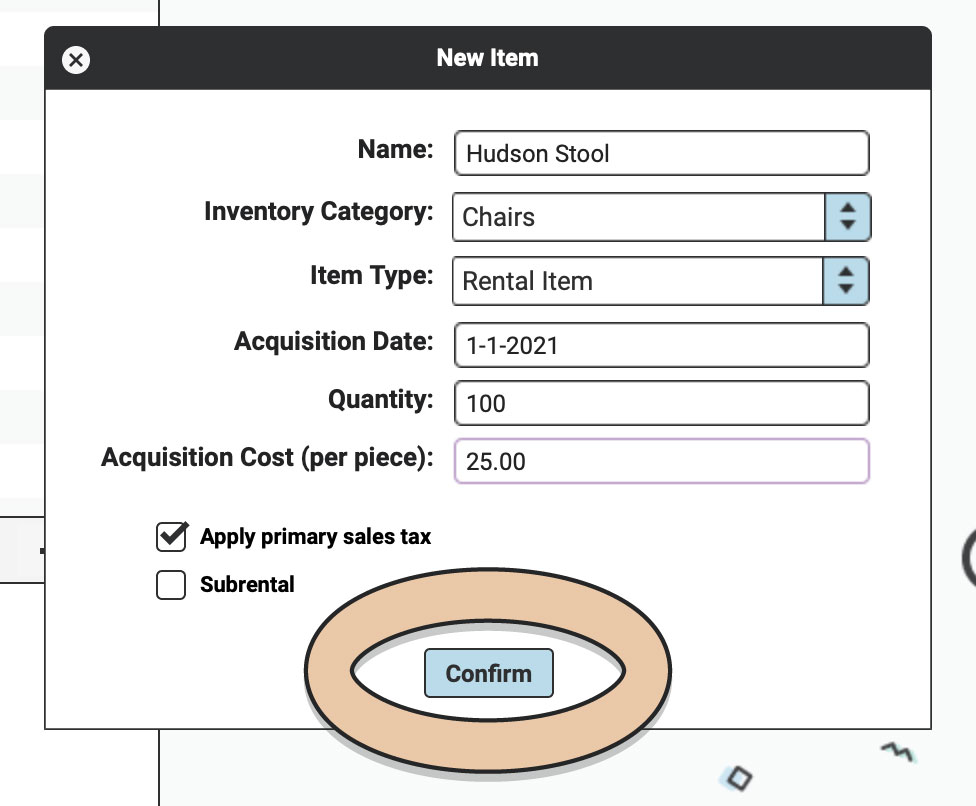
Now let’s talk about the other details you can store about your Item. For instance, you can include a Custom ID for that item. Some users already have a coding system and want to include it here. This can be a helpful tool if your staff is already used to using Item codes for your inventory. If you don’t already use any codes or IDs, though, we suggest you skip this field.
We’ve already added a quantity, but whenever you’d like to update the quantity of an Item, you’ll create a new Quantity Change Event by clicking the “New” button.
Next, enter the Replacement Cost for the item. This isn’t required, but again, can be quite helpful in the future when you’re evaluating the performance of your collection or charging a client for damages.
You can tab through the rest of the fields to enter the additional information.
Rental Price is the default rental price for the Item. It can be changed on any individual Order.
Use the Number of Uses field to include a prediction of how many times you think the item will be rented before it needs to be retired. There isn’t a science to this but it can be a helpful bit of information down the road when you evaluate what to liquidate or buy more of.
Origin is a place for you to record the vendor or store you purchased the Item from. It is a smart field within RW Elephant. Once you’ve entered a vendor once, whenever you start typing that name again in the future, you’ll be able to choose it from the list below the field.
Include Dimensions for your Item in whatever units you’d like. We suggest that you use these fields as consistently as possible (for instance, always Length, Width, Height). It is also best to use the same units of measure throughout your rental collection; if you use inches, don’t switch to feet for just some Items.
Within the Volume field, you can measure the amount of space your item takes up when it is stored or out for delivery. This is a helpful tool when planning to fill your delivery trucks and how much can fit on each truck. Just like Dimensions, we recommend using a consistent form of measurement (i.e. cubic feet, cubic meters, etc.) The Volume field will only be useful if you input the Volume for ALL of your items.
The Description field is a place for you to include lots of information about your Item. This information will be seen by your Clients in your Online Public Gallery among other places so you’ll want to consider that as you write the copy. The Description field is also a searchable field within RW Elephant so anything you include here will influence the search results you ultimately get. Additionally, use Hyperlinks within Item Descriptions to lead visitors on your website wherever you’d like them to go.
Use Tags to relate Items to one another. Use any words you’d like within the Tags section. They can emphasize specific characteristics and connect items within your Online Gallery.
The Internal Note field stores information about the Item that will never be shown to your Client. Use this field to indicate the Item’s location in your warehouse, the required set-up time, or other info you want to keep handy but not share with the Client.
The Line Item Note field allows you to add default notes about the Item that will auto-populate on your Invoices. Line Item Notes can also be edited on an Order-by-Order basis.
Next, you’ll find the Location field. This is a place to enter where the Inventory Item lives in your warehouse, garage, storage unit, etc. The Location field will appear on your Pull Ticket PDFs when your team is prepping for the event so they’ll know just where to find the Item.
Within RW Elephant, you can also add two additional customizable fields to your Items. Users often create custom fields here for the original manufacturer’s SKU of the Item or other information that they want to collect for all or most of their Items. If you need custom fields for your Inventory Items, save your current Item and jump on over to the Item Settings Set-up Step. Then come back and finish up this Item.
In addition to the text fields for each item, you’ll see a group of tick boxes in the lower right corner of your browser window. The first set of tick boxes are for notifying your delivery crew if an item is Stackable. If you want to be specific about how your items are loaded, go ahead and tick “item is stackable”.
From there, you can indicate if there are no restrictions, if the item should only go on the top, on the bottom, or has a maximum number that can be stacked together.
If you want this Inventory Item to show up in your Online Gallery for Clients to see, leave the “Display in Public Gallery” box checked. If you don’t, untick it.
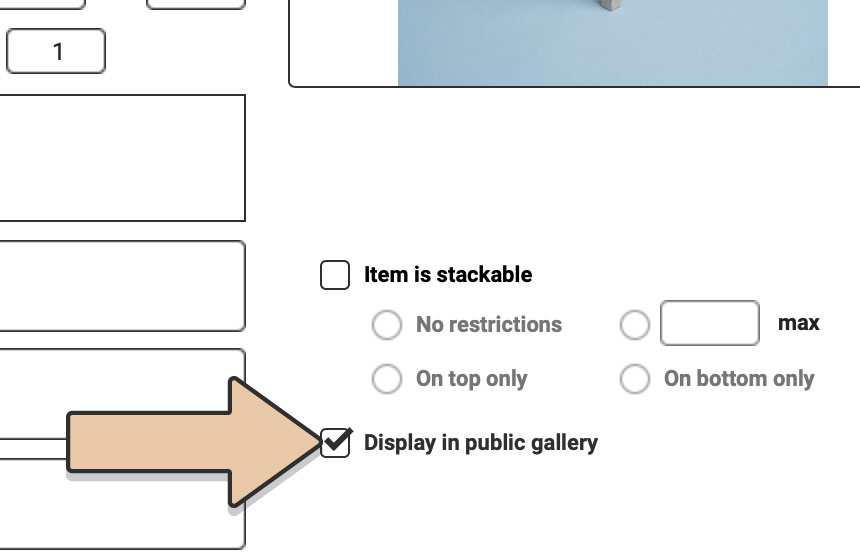
Now that you’ve got all that info about the Item entered, click the “Save Item” button at the top of the screen.
You can add more Items to this Category or create additional Categories and go to town.
As you create more Items, keep in mind that you can easily duplicate Items. Simply select the Item you’d like to duplicate, right click on it, and choose “Duplicate Item.”
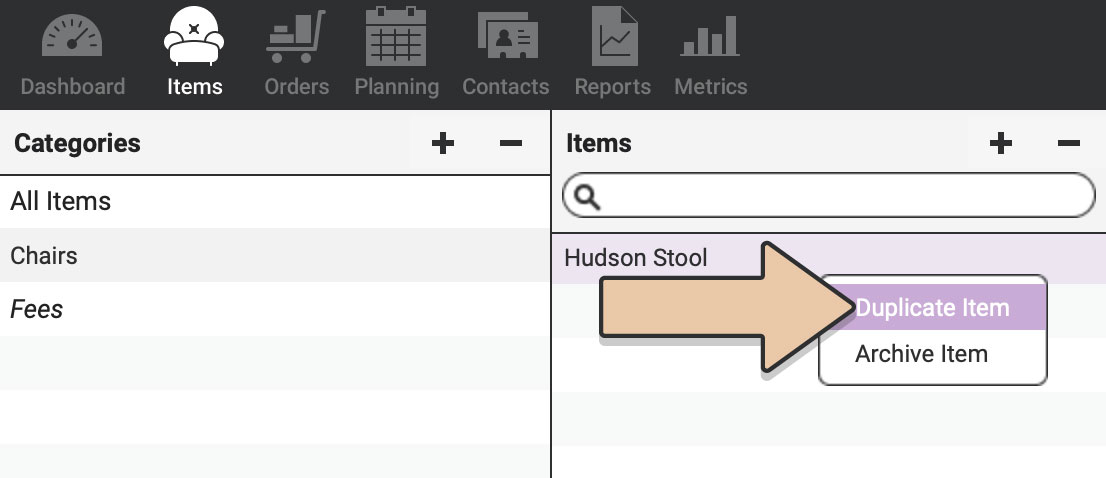
This will create a new Item with all of the same information except the quantity. You’ll want to manually Edit the Item Name and then create a new Quantity Change Event. All the other information can be kept the same or modified as needed.
Before you go crazy adding and duplicating Items though, don’t forget to add some pizazz to your Inventory Items with Photos! Oooooooh!